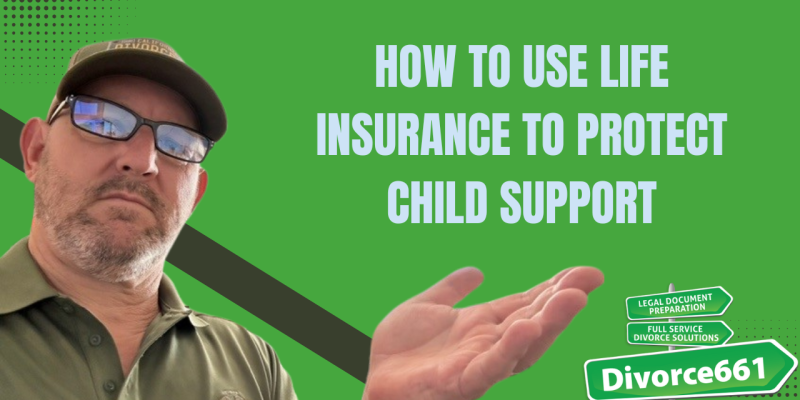How To Use Life Insurance To Protect Child Support
When a divorce occurs, financial arrangements such as child support and spousal support become crucial for ensuring the well-being of the family left behind. However, what happens if the primary wage earner unexpectedly passes away? This is a question many overlook, but it’s vital to address. Life insurance is a powerful tool that can safeguard child support payments and provide peace of mind for both parents and children in these difficult circumstances.
In this article, we’ll explore how life insurance can be strategically used to protect child support obligations after divorce, drawing on insights from Tim Blankenship of Divorce661.
The Risk of Support Payments Stopping After Death
Consider a common scenario: a husband and wife get divorced, and the husband is required to pay monthly spousal support and child support for a set number of years—often until a child turns 18. But what if the husband, who is the primary wage earner, suddenly dies? The immediate consequence is that all support payments stop, leaving the ex-spouse and children without that critical financial support.
This sudden loss can be devastating. Retirement accounts or other beneficiaries do not cover these support payments, and courts generally cannot intervene to replace lost income from a deceased payor. The surviving spouse and children face a financial gap with limited options.
Using Life Insurance to Bridge the Gap
One effective solution is for the payor—the ex-husband in this example—to take out a life insurance policy specifically designed to cover these support payments. Here’s how it typically works:
- Policy Ownership: The ex-spouse receiving the support (for example, the wife) owns the life insurance policy. This ownership grants her full control over the policy, including the ability to choose and change beneficiaries.
- Premium Payments: The payor (ex-husband) remains responsible for paying the premiums on the policy. This arrangement ensures the policy stays active as long as the support payments are due.
- Beneficiaries: The policy’s beneficiaries can be the ex-spouse, the children, or both. This guarantees that if the payor dies, the life insurance proceeds will replace the lost support payments.
By structuring the life insurance policy this way, the receiving spouse and children continue to receive financial support without interruption. It prevents what could otherwise be a “double tragedy”—losing both the breadwinner and the financial support they provided.
Real-Life Example: Protecting a Stay-at-Home Mom
Let’s put this into perspective with a more detailed example. Imagine a stay-at-home mom who has not worked outside the home for 20 years. The husband has been the primary wage earner, working full-time and approaching retirement. After divorce, he is required to pay both spousal support and child support.
If the husband dies unexpectedly, all these payments stop instantly. The mom, who may have limited or no personal income or retirement savings, suddenly faces a serious financial crisis. Without life insurance in place, there is no fallback to continue those crucial payments, and the courts cannot step in to fill the gap.
However, if a life insurance policy is established with the ex-wife as the owner and the children as beneficiaries, the insurance proceeds can continue to provide the necessary financial support. This arrangement creates a safety net that protects the family’s financial stability during an already difficult time.
Why Life Insurance Is an Important Consideration in Divorce Agreements
Many people do not initially think about life insurance as part of divorce settlements or support arrangements. However, it is a vital consideration to ensure ongoing financial security. Here are some key reasons why life insurance should be part of the conversation:
- Guarantees Continuity: It guarantees that support payments will continue even if the payor dies unexpectedly.
- Protects Children’s Future: It ensures that children’s needs are met without disruption, providing stability during challenging times.
- Legal Clarity: Establishing life insurance policies as part of divorce agreements clarifies financial responsibilities and reduces disputes later.
- Peace of Mind: Both parties gain peace of mind knowing that financial obligations are secured beyond the payor’s life.
Final Thoughts
Divorce is complicated enough without the added worry of what happens if the payor of child and spousal support dies unexpectedly. Life insurance offers a practical and effective solution to protect support payments and ensure the financial well-being of the receiving spouse and children.
By carefully structuring life insurance policies—where the receiving spouse owns the policy, the payor pays premiums, and the beneficiaries include the spouse and children—families can avoid financial hardship and maintain stability during difficult transitions.
If you’re navigating divorce and support arrangements, consider discussing life insurance options with your attorney or financial advisor. Protecting child support payments isn’t just about legal obligations; it’s about safeguarding the future of those who depend on it.
For more insights on divorce and financial planning, visit Divorce661.com.

